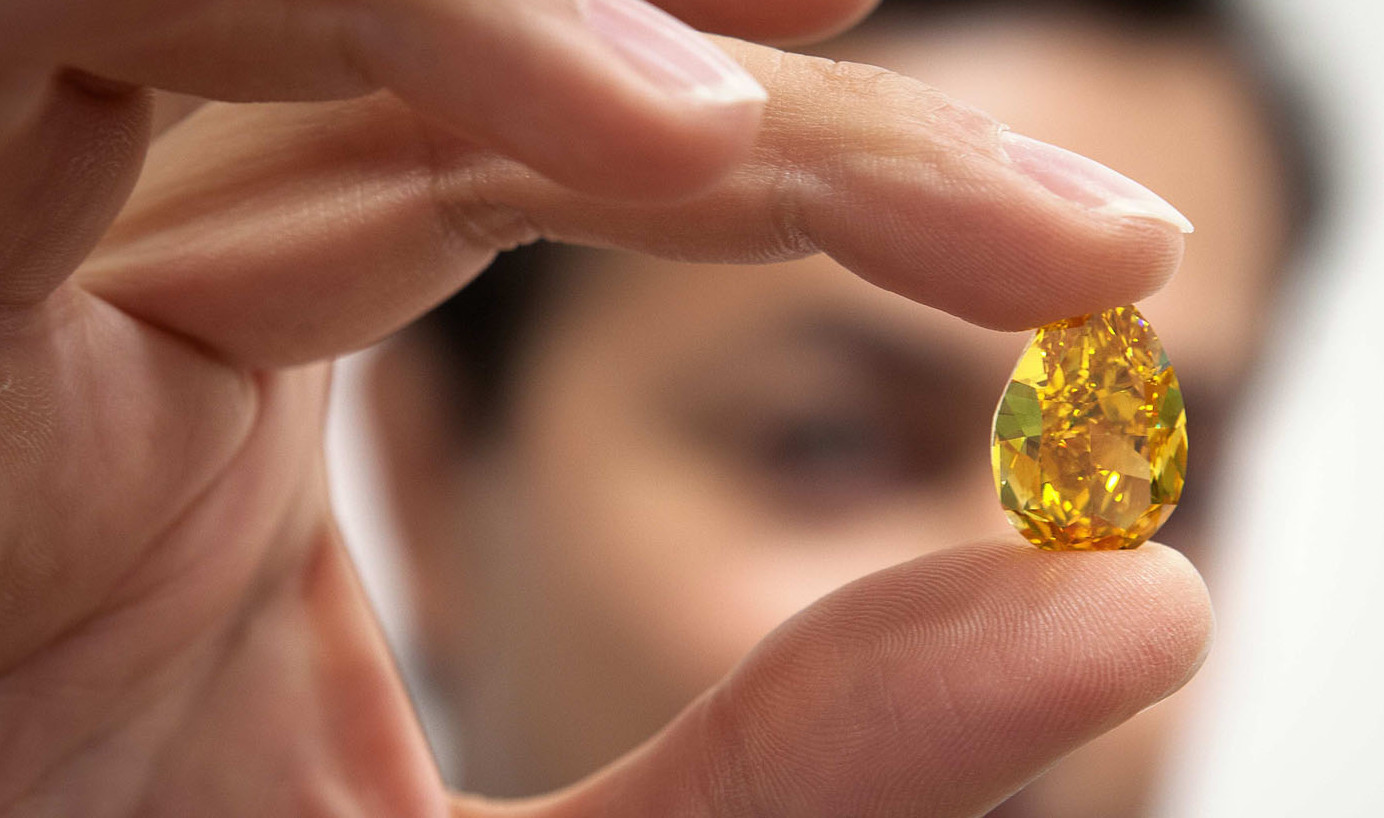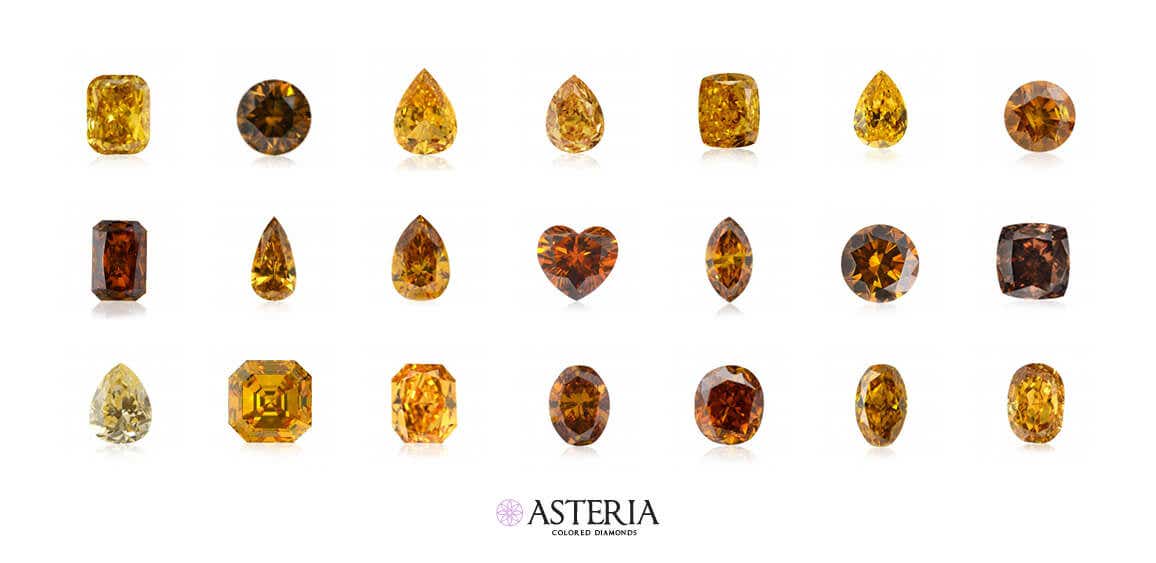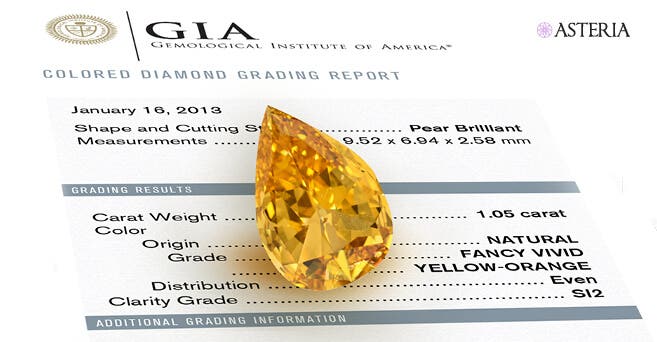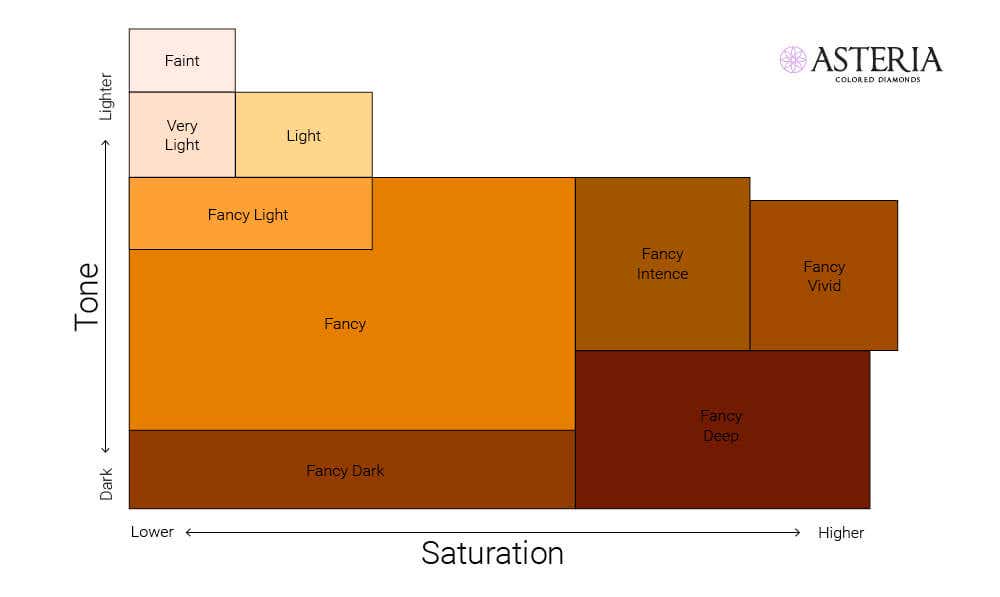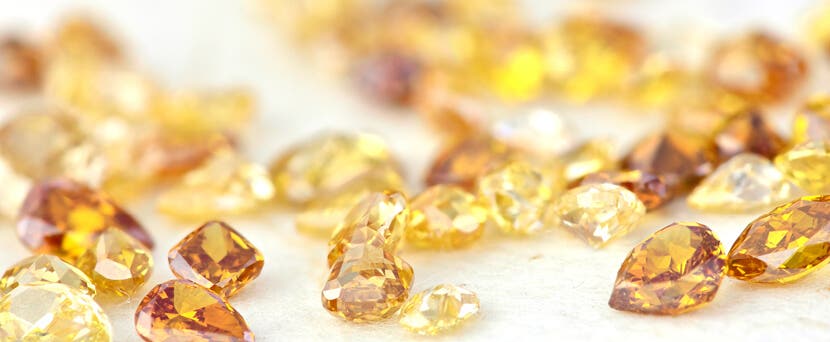Orange Diamonds Wiki: Everything you need to know before choosing the perfect Orange Diamond ring
Ranging from vibrant orange to warm and mellow amber, rare orange diamonds – or “fire diamonds” as they are often called - are generally regarded as the most vibrant and beautiful of all the colored diamonds. Formed through a grouping of nitrogen atoms during the stone’s creation process, these stones are a favorite with diamond collectors and investors alike.
With our orange diamond education article, we’ll bring you all the information you need to make a knowledgeable decision, whether you’re a first time owner, or an experienced investor.
We’ll take you through all you need to know and more, about natural orange diamonds, including how they are formed, how they are graded, and how you can accurately determine the value of a stone before you make your priceless purchase.
How are orange diamonds formed?
The distinctive color of natural orange diamonds is created by the presence of nitrogen, the same element that give yellow diamonds their unique hue. However, while nitrogen is commonly present in nature, natural orange diamonds are formed through a rare process of nitrogen atoms grouping in a particular permutation during the creation of the diamond. If the conditions for this particular arrangement are present, the diamonds then absorb blue and yellow light, which on the color spectrum, come together to radiate an orange hue.
More rarely, when nitrogen atoms are consistently distributed throughout the carbon structure, the diamond absorbs green light as well as blue light. Such diamonds are called Type 1B diamonds, and have a darker color than Type 1A diamonds. Depending on the precise concentration and spread of the nitrogen atoms, natural orange diamonds come in a variety of overtones and intensities, from faint orange with yellow or brown as modifying colors, to Fancy Vivid or “pumpkin” orange.
Where are orange diamonds quarried?
Fancy orange diamonds are predominantly found in one of two places: Australia’s Argyle mines or the mines of South Africa.
Are orange diamonds rare?
The majority of orange diamonds are type 1B, indicating a scattering of individual nitrogen atoms consistently throughout the stone. Overall, less then 0.1% of diamonds are considered type 1B, which means that these stones are comparable to Type 2B diamonds for being the rarest kind. However, orange diamonds are less rare than some other natural colored diamonds such as blue, red, or pink diamonds.
Within orange diamonds, the purity of the color tone largely determines its rarity. While it is common to find Fancy orange diamonds with modifying secondary color hues (such as overtones of brown, yellow, or pink), pure Fancy orange diamonds are highly uncommon; not nearly as rare as coveted Fancy red diamonds, but comparable to certain pink and blue diamonds.
What are “pumpkin” and “orangy” diamonds?
Pure Fancy Vivid orange diamonds, which are extremely rare, are also referred to as "pumpkin diamonds" as they occur in the same tone and intensity as the color of a pumpkin. These include Fancy Vivid orange diamonds, as well as Vivid orange diamonds with a yellowish tone.
“Orangy” diamonds refer to diamonds with less than a 25% saturation of the color orange, which makes orange the secondary hue. The primary color for these diamonds is often yellow, brown, pink, or more uncommonly, the much sought after red. The price and demand for “orangy” diamonds depend greatly on the characteristics and value of the secondary color.
Natural orange diamonds prices & investment opportunities
Natural colored diamonds represent excellent investment opportunities for several reasons: they are compact with a high size to value ratio, they don’t require registration as an asset, and most importantly, they’ve seen unprecedented valuations with exponential returns – in some cases up to 600% over the course of a decade.
The most lucrative investment choices are orange diamonds with intense color saturation and the highest carat that you can purchase within your desired budget.
However, diamond dealers and alternative investment professionals have noted recent trends that indicate the increasing desirability – and increased prices - of diamonds with mixed hues, such as brownish-orange.
The most accurate indications of pricing information for diamonds is typically through auction house records, and a key example of orange diamond valuations include “the Orange”, 14.82 carat pear shaped Fancy Vivid Orange VS1 pear sold at Christie’s Geneva auction in November 2013 for $2.4 million per carat. The diamond’s price tag of nearly $36 million shattered previous forecasts, which hovered around $20 million.
Orange diamonds for sale by Astteria
Natural loose orange diamonds value by the 4c's
The pricing of diamonds – whether they’re colored or colorless - is based on four key parameters: Color, Carat, Clarity and Cut – the well-known 4Cs of diamond valuation. However, unlike with white diamonds, the value of a colored diamond is determined primarily by its color. The more dominant orange is as a diamond’s primary color, and the higher the intensity of this base color, the more valuable it will typically be.
Professional gemological institutes officially measure a diamond’s color according to three main parameters: Hue, Tone and Saturation.
At the end of the process, the color definition will be listed in the diamond’s official certificate of authenticity, an important consideration when purchasing a diamond to ensure that the value you pay for is the value you get.
The parameters affecting the Fancy orange color definition
Hue represents the diamond’s dominant color, orange in this case. The hue value will be specified in the certificate for your diamond, accompanied by any lesser or secondary hues.
Secondary color modifiers found in natural orange diamonds: brown, yellow and the very rare red color.
As an orange diamond is a true hybrid, formed by the combination of yellow and red on the color spectrum, strong modifying colors – typically combinations of brown and yellow– commonly occur in these stones. However, such mixed hue diamonds are typically less expensive, as orange diamonds are rarest – and more valuable – when they exist without any modifying colors.
The only instance in which orange diamonds with modifying colors are considered more valuable than pure Fancy orange diamonds is when they have secondary hues of a color that’s even more rare than orange, such as red or pink. Thus, a “Fancy reddish orange” diamond will be considered more valuable than a pure orange stone of an equal intensity.
Saturation
Saturation refers to the strength of color, or how much color is present and how intense it is. The further along this spectrum you go, the richer and more vibrant the orange is - and the richer a diamond’s color saturation, the more it will be worth. Thus, a Fancy Intense orange diamond will be worth more than a Fancy orange diamond.
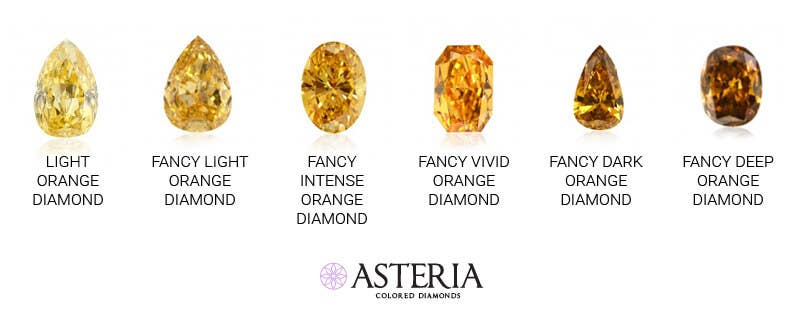
Tone
Tone refers to the penetration of light, or lightness or darkness of an orange diamond, which make affect the perceived intensity of the diamond’s color. Thus, to the untrained eye, a Fancy orange with a darker tone can be mistaken for the more valuable Fancy Intense orange. The levels of tone are divided as follows - Very light, Light, Medium light, Medium, Medium dark, Dark, Very dark.
Speak to our diamond experts for post and pre sale valuation services.
Intensity
The intensity color grading of a diamond is based on a combination of saturation and tone, and represents the color’s strength and vibrance. The intensity of a diamond’s hue greatly affects it’s cost and demand. The more intense the color, the rarer the diamond.
The color grading of the GIA, is divided into 9 color intensities: Faint, Very Light, Light, Fancy Light, Fancy, Fancy Intense, Fancy Vivid, Fancy Dark, and Fancy Deep. Light diamonds tend to have a bright, pastel hue while Fancy Dark will have a deeper, richer color.
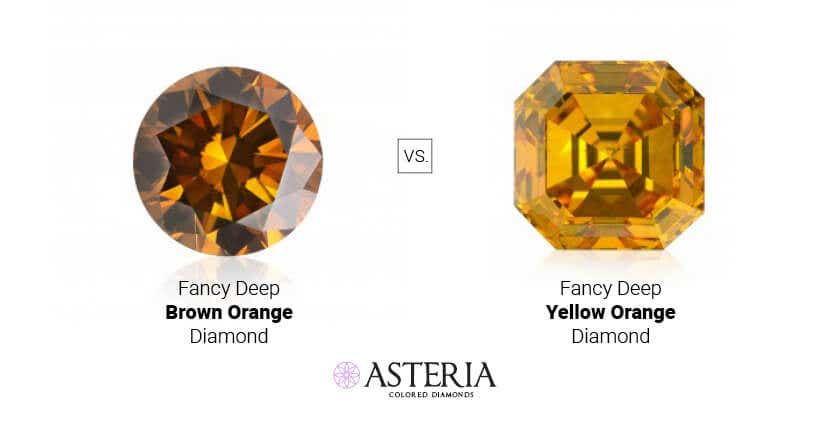
How do fluorescence and color distribution affect the value of orange diamonds?
Fluorescence is a natural phenomenon that is present in up to one-third of diamonds, and which causes them to glow when exposed to ultraviolet light. Typically, this appears as a blue glow, but can also occur in yellow, orange, and green. In orange diamonds, the glow typically appears as a medium to strong yellow, lending a golden luminosity to the stone and making it look more pastel.
Color distribution is also an important color parameter in determining the value of orange diamonds, and refers to how evenly the color extends is spread across the stone. Color distribution is defined as either even or uneven. Uneven color distributions can negatively affect a diamond’s appearance and value.
Natural loose orange diamond prices By Carat, Clarity & Cut
While color is the primary factor influencing the pricing of diamond, the other 3 C’s - Carat, Clarity and Cut – are also important considerations.
Carat – The carat parameter refers to the diamond’s weight. 1 carat is defined as about 0.2 grams, or 100 points. In general, pricing by carats is higher for heavier diamonds compared to a lighter diamond with the same values of clarity or shade.
Clarity - indicates a stone’s structural perfection. While flaws are not usually visible to the human eye, the clarity scales set by gemological institutes such as the GIA, specify the diamonds’ level of internal clarity when magnified 10,000 times.
The clarity rating is represented in a scale that includes 9 grades divided into 6 groups:
| FL | Flawless:
No inclusions or blemishes are visible even at 10x magnification. |
| IF | Internally Flawless:
No inclusions, only blemishes visible at 10x magnification. |
| VVS1
VVS2 |
Very, Very Slightly Included:
Inclusions slightly visible at 10x magnification. |
| VS1
VS2 |
Very Slightly Included:
Minor inclusions clearly visible under 10x magnification. |
| SI1
SI2 |
Slightly Included:
Minor and major inclusions visible at 10x magnification. |
| I1
I2 I3 |
Included:
Inclusions are obvious at 10x magnification and visibly affect transparency and brilliance. |
Natural Fancy orange diamonds generally tend to have clarities that fall within the VS1 to I1 range. While lower value orange diamonds may fall below this range, the vibrance of the color can often hide even major flaws that would be otherwise visible to the naked eye. Thus, it’s important to ensure you get a professional, personalized valuation before investing in a colored diamond.
Cut - refers to the way the diamond is polished to best flatter its natural qualities, maximize its color, augment its sparkle and make it look larger than it’s actual carat weight.
Round cuts – which are popular with white diamonds due to their tendency to reflect white light and enhance sparkle - tend to lower the perceived intensity of the color and make the saturation appear fainter. Thus, orange diamonds, like other colored diamonds, are generally cut into pear, radiant, cushion, or other unconventional shapes, which reflects less white light and work to enhance the intensity of the color.
Natural orange diamonds vs. treated orange diamonds
The exceptional rarity and high price of these wonderful gems has led to a huge and unsatisfied demand for natural orange diamonds, which the market cannot meet. As a result, a niche of treated orange diamonds has emerged. Prepared in laboratory conditions, these diamonds attempt to imitate natural stones and provide a cheaper, artificial solution.
Treated orange diamonds are in fact white diamonds sent to the lab to undergo a chemical process or HPHT (High Pressure High Temperature) process in order to create pressure so great that the color of the diamond’s shell artificially changes to orange while its interior remains white.
If you insist on getting a rare and natural orange diamond, make sure it has a certificate of authenticity issued by a recognized gemological institute (such as the GIA) or get one issued immediately upon receipt to confirm that the diamond’s declared values match test results.


